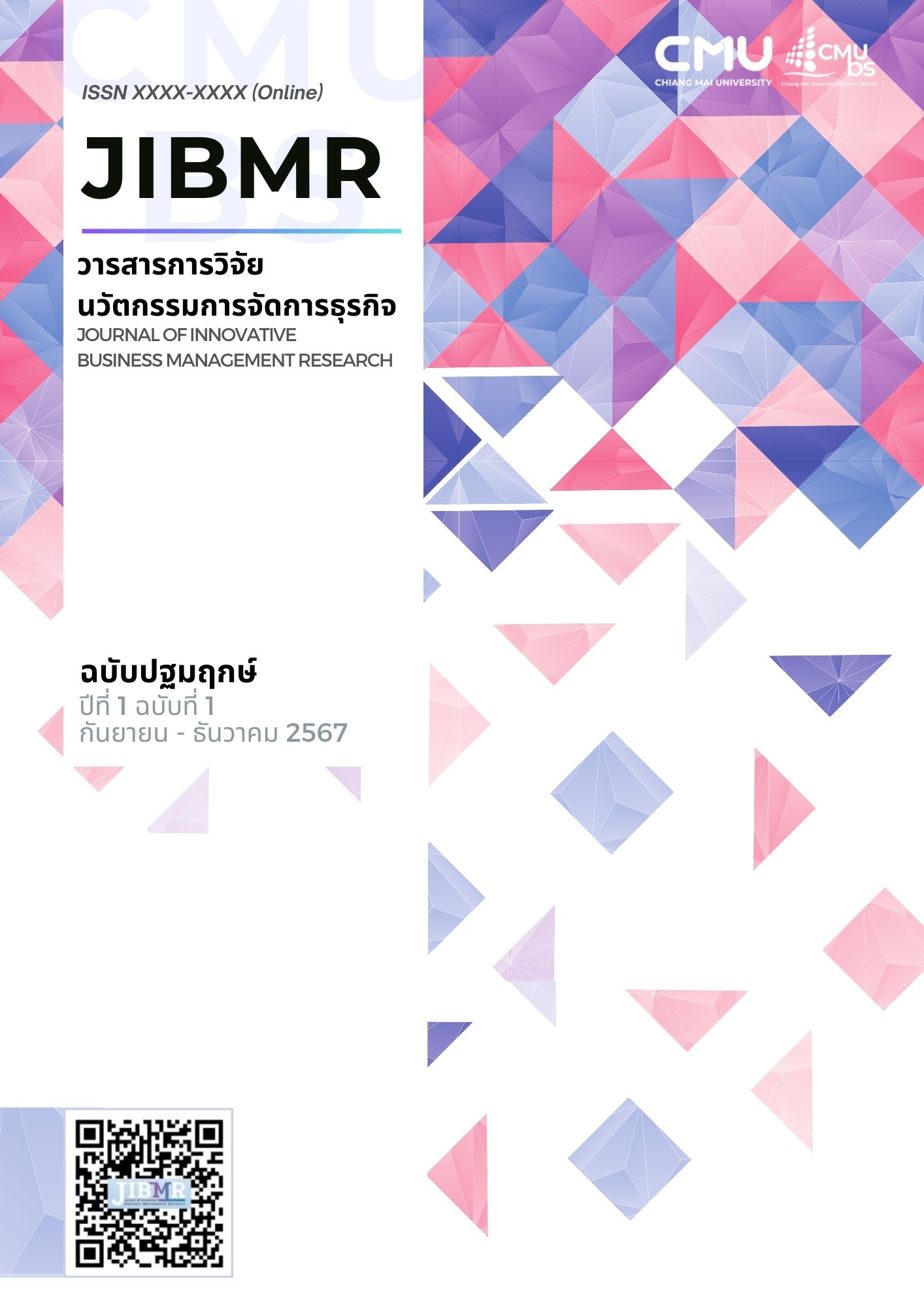การสำรวจองค์ประกอบของการตลาดเชิงเนื้อหาโดยใช้ การประมวลผลภาษาธรรมชาติ: กรณีผ้าทอพื้นเมือง
คำสำคัญ:
การตลาดเชิงเนื้อหา, กระบวนการประมวลผลภาษาธรรมชาติ , เสื้อผ้าทอพื้นเมือง, ธุรกิจขนาดกลางและขนาดย่อมบทคัดย่อ
การใช้สื่อสังคมออนไลน์อย่างแพร่หลายในกลุ่มธุรกิจขนาดกลางและขนาดย่อม (SMEs) ของไทย ชี้ให้เห็นถึงความสำคัญของการใช้กลยุทธ์การตลาดเชิงเนื้อหาอย่างมีประสิทธิภาพ อย่างไรก็ตามธุรกิจ SMEs ส่วนใหญ่ในประเทศไทยยังคงประสบปัญหาในการประยุกต์ใช้การตลาดเชิงเนื้อหาโดยขาดความเชี่ยวชาญที่ชัดเจน งานวิจัยนี้นำกลยุทธ์ข้อความของ Ashley และ Tuten (2015) มาศึกษาองค์ประกอบของข้อความที่จำเป็นต่อการตลาดเชิงเนื้อหาในตลาดเสื้อผ้าทอพื้นเมือง โดยแบ่งประเภทข้อความออกเป็น 3 รูปแบบ คือ การจูงใจเชิงหน้าที่ การจูงใจเชิงอารมณ์ และการจูงใจเชิงประสบการณ์ งานวิจัยนี้ใช้กระบวนการประมวลผลภาษาธรรมชาติเพื่อพัฒนารูปแบบปัญญาประดิษฐ์ ตั้งแต่การใช้แบบจำลองสำเร็จรูป การปรับแต่งแบบจำลองและนำไปใช้ในขั้นตอนสุดท้าย ข้อมูลที่ใช้ในการฝึกฝนแบบจำลองมาจากข้อความจำนวน 137 ข้อความที่โพสต์โดย SMEs ด้านเสื้อผ้าทอพื้นเมือง 8 แห่งบนเพจเฟซบุ๊ก ผลการวิจัยให้ข้อแนะนำแก่ผู้บริหารธุรกิจเสื้อผ้าทอพื้นเมืองในประเทศไทย รวมถึงผู้บริหารธุรกิจ SMEs โดยทั่วไป เกี่ยวกับแนวทางในการสร้างการตลาดเชิงเนื้อหาที่มีประสิทธิภาพและคุ้มค่า นอกจากนี้ งานวิจัยยังขยายขอบเขตการประยุกต์ใช้กลยุทธ์ข้อความของ Ashley และ Tuten (2015) ในบริบทของ SMEs ในประเทศที่เศรษฐกิจกำลังเติบโต
References
Ahmad, N. S., Musa, R., & Harun, M. H. M. (2016). The impact of social media content marketing (SMCM) towards brand health. Procedia Economics and Finance, 37, 331–336.
Ashley, C., & Tuten, T. (2015). Creative strategies in social media marketing: An exploratory study of branded social content and consumer engagement. Psychology & Marketing, 32(1), 15–27.
Baltes, L. P. (2015). Content marketing-the fundamental tool of digital marketing. Bulletin of the Transilvania University of Brasov. Series V: Economic Sciences, 8(2), 111-118.
Carneiro, T., Da Nóbrega, R. V. M., Nepomuceno, T., Bian, G. B., De Albuquerque, V. H. C., & Reboucas Filho, P. P. (2018). Performance analysis of google colaboratory as a tool for accelerating deep learning applications. IEEE Access, 6, 61677-61685.
Chomsky, N. (1961). Some Methodological Remarks on Generative Grammar. WORD, 17(2), 219-239.
Conneau, A., Khandelwal, K., Goyal, N., Chaudhary, V., Wenzek, G., Guzmán, F., … & Stoyanov, V. (2019). Unsupervised cross-lingual representation learning at scale. Proceedings of the 58th Annual Meeting of the Association for Computational Linguistics, Association for Computational Linguistics, 8440–8451.
DeMers, J. (2013). The top 7 content marketing trends that will dominate 2014. Retrieved May 11, 2022, from https://www.bigvoodoo.com/wp-content/uploads/forbes.pdf
ETDA. (2022). Thailand Internet User Behavior 2022. Retrieved January 2, 2024, from https://www.etda.or.th/getattachment/78750426-4a58-4c36-85d3-d1c11c3db1f3 /IUB-65-Final.pdf.aspx
Hartmann, J., & Netzer, O. (2023). Natural language processing in marketing. Artificial Intelligence in Marketing, 20, 191-215.
Holliman, G., & Rowley, J. (2014). Business to business digital content marketing: marketers’ perceptions of best practice. Journal of Research in Interactive Marketing, 8(4), 269-293.
Jahn, B., & Kunz, W. (2012). How to transform consumers into fans of your brand. Journal of Service Management, 23(3), 344-361.
Khumtaveeporn, I., & Wattanasuwan, K. (2023). AI sentiment analysis for destination branding: A case study of Buriram, Thailand. Thammasat Business Journal, 46(180), 50-74.
Kilgour, M., Sasser, S. L., & Larke, R. (2015). The social media transformation process: Curating content into strategy. Corporate Communications: An International Journal, 20(3), 326–343.
Kotler, P. (2010). The prosumer movement. In: B. Blättel-Mink, & K.-U. Hellmann (Eds), Prosumer revisited (pp. 51–60). Wiesbaden, German: VS Verlag für Sozialwissenschaften. https://doi.org/10.1007/978-3-531-91998-0_2
Kotler, P., Kartajaya, H., & Setiawan, I. (2010). Marketing 3.0: from products to customers to the human spirit. Hoboken: John Wiley & Sons.
Lowphansirikul, L., Polpanumas, C., Jantrakulchai, N., & Nutanong, S. (2021). WangchanBERTa: Pretraining transformer-based Thai language models. arXiv. https://doi.org/10.48550/arXiv.2101.09635
Manning, C. D., & Schutze, H. (1999). Foundations of statistical natural language processing. Cambridge: MIT press.
Mathew, V., & Soliman, M. (2021). Does digital content marketing affect tourism consumer behavior? An extension of technology acceptance model. Journal of Consumer Behaviour, 20(1), 61-75.
McLean, K. C., & Breen, A. V. (2009). Processes and content of narrative identity development in adolescence: Gender and well-being. Developmental Psychology, 45(3), 702-710.
Nawaz, Z., Zhao, C., Nawaz, F., Safeer, A. A., & Irshad, W. (2021). Role of artificial neural networks techniques in development of market intelligence: A study of sentiment analysis of eWOM of a women’s clothing company. Journal of Theoretical and Applied Electronic Commerce Research, 16(5), 1862-1876.
Norman, K., Li, Z., Golwala, G., Sundaram, S., Lee, P., & Allebach, J. (2019). New results for natural language processing applied to an on-line fashion marketplace. Society for Imaging Science and Technology, 8, 1-8.
Phatthiyaphaibun, W. (2022). PyThaiNLP/pythainlp: PyThaiNLP v3.1.0-dev1. Retrieved February 24, 2022, from https://pythainlp.github.io/
Peng, J., Agarwal, A., Hosanagar, K., & Iyengar, R. (2018). Network overlap and content sharing on social media platforms. Journal of Marketing Research, 55(4), 571-585.
Phumchusri, N., & Chugh, N. (2022). User-generated content data analysis using machine learning methods: a case study in Bangkok, Thailand. International Journal of Business and Data Analytics, 2(1), 72-109.
Pulizzi, J., & Handley, A. (2014). B2B content marketing: 2015 benchmarks, budgets, and trends—North America. Retrieved January 22, 2024, from https://contentmarketinginstitute.com/wpcontent/uploads/2013/10/B2B_Research_2014_CMI.pdf
Reisenbichler, M., Reutterer, T., Schweidel, D. A., & Dan, D. (2022). Frontiers: Supporting content marketing with natural language generation. Marketing Science, 41(3), 441-452.
Rungrueang, A., Khantanapha, N, & Piriyakul, R. (2020). High Performance Practice in Thai SMEs Textile Industry. Academic Journal Bangkokthonburi University, 9(2), 17–32.
SET. (2022). Empower and support the growth of Thai SMEs/Startups with LiVE Platform and LiVEx. Retrieved December 30, 2023, from https://www.set.or.th/th/about/setsource/insights/article/85-livex.
Shankar, V., & Parsana, S. (2022). An overview and empirical comparison of natural language processing (NLP) models and an introduction to and empirical application of autoencoder models in marketing. Journal of the Academy of Marketing Science, 50, 1324-1350.
Suttanurak, J., Aryuwat, P., Pongsart, T., & Thamrongyoswittayakul, C. (2022). Development of Artificial Intelligence-Based Application Promoting SMCE and SME for Thailand Organic Valley. Suan Sunandha Science and Technology Journal, 9(1), 17-24.
Tay, Y., Dehghani, M., Rao, J., Fedus, W., Abnar, S., Chung, H. W., & Metzler, D. (2022). Scale efficiently: Insights from pre-training and fine-tuning transformers. Paper presented at ICLR 2022, Wisconsin, USA, 1-18.
The Office of SMEs Promotion. (2022). Dashboard SME Big Data. Retrieved December 30, 2023, from https://www.smebigdata.com/
Wisesight. (2023). Customer Generations 2023: Insight into behavior according to age: How does each generation behave? Retrieved January 2, 2024, from https://wisesight.com/th/customer-generations-2023.
Downloads
เผยแพร่แล้ว
How to Cite
ฉบับ
บท
License
Copyright (c) 2025 วารสารการวิจัยนวัตกรรมการจัดการธุรกิจ

This work is licensed under a Creative Commons Attribution-NonCommercial-NoDerivatives 4.0 International License.
บทความที่ได้รับตีพิมพ์เป็นลิขสิทธิ์ของวารสาร


